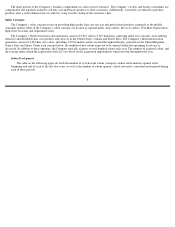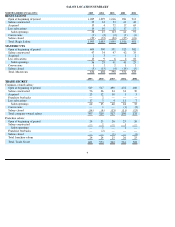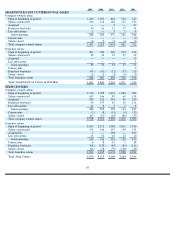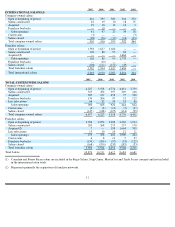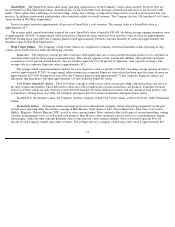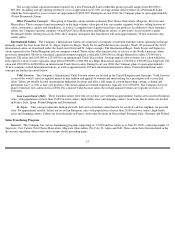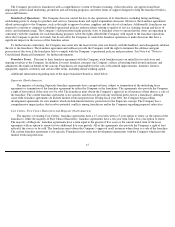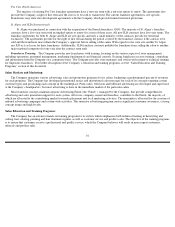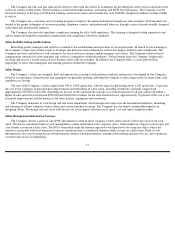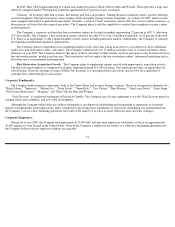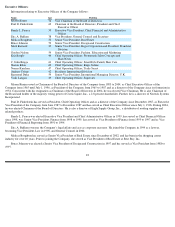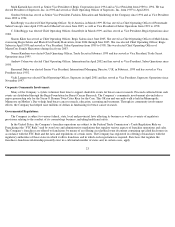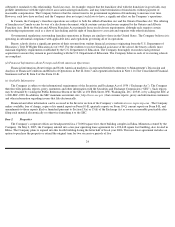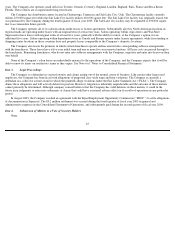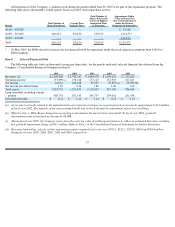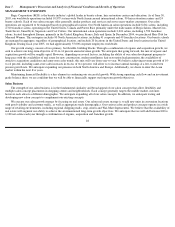Supercuts 2005 Annual Report Download - page 19
Download and view the complete annual report
Please find page 19 of the 2005 Supercuts annual report below. You can navigate through the pages in the report by either clicking on the pages listed below, or by using the keyword search tool below to find specific information within the annual report.
and anticipating industry trends for purposes of pricing and staffing. The Company has expanded the corporate information systems to deliver
on-line information of product sales to improve its inventory control system, including monthly replenishment recommendations for a salon.
Management believes that its information systems provide advantages in planning and analysis which are generally not available to a majority
of its competitors.
Salon Competition:
The hair care industry is highly fragmented and competitive. In every area in which the Company has a salon, there are competitors
offering similar hair care services and products at similar prices. The Company faces competition within malls from companies which operate
salons within department stores and from smaller chains of salons, independently owned salons and, to a lesser extent, salons which, although
independently owned, are operating under franchises from a franchising company that may assist such salons in areas of training, marketing
and advertising.
Significant entry barriers exist for chains to expand nationally due to the need to establish systems and infrastructure, recruitment of
experienced hair care management and adequate store staff, and leasing of quality sites. The principal factors of competition in the affordable
hair care category are quality, consistency and convenience. The Company continually strives to improve its performance in each of these areas
and to create additional points of difference versus the competition. In order to obtain locations in shopping malls, the Company must be
competitive as to rentals and other customary tenant obligations.
Beauty School Business Strategy:
The Company is currently pursuing acquisitions of beauty schools in North America. Operating beauty schools is complementary to the
salon business as it allows the Company to attract, train and retain valuable employees. The Company expects to open and acquire additional
beauty schools in the future in order to take advantage of this opportunity. The principle activity of the beauty schools is the teaching of
beauticians to prepare for their licensing. The activities also include clinic and school sales of products to students and customers and other
miscellaneous sales. Subjects available for enrollment include cosmetology, nail art and esthetic programs. Most schools are certified by the
U.S. Department of Education (ED) for participation in Federal Title IV Student Financial Assistance Programs. As of June 30, 2005, the
Company operated 24 such facilities. The for-profit beauty school industry represents approximately 1,000 schools generating an estimated $1
billion annually. Beauty schools are highly profitable and offer predictable cash flows. Given the attractive unit economics and the fact that
Regis Corporation is the largest employer of beauty school graduates, the Company seeks to be the largest operator of beauty schools, primarily
through the acquisition of existing schools.
Following is a summary of the Company’s beauty school locations:
Beauty School Growth Opportunities. The Company’s beauty school expansion strategy currently focuses on school acquisitions.
However, the Company plans to supplement acquisition growth with new school construction as permitted by the Department of Education
(ED).
Beauty School Organic Growth . Initially, organic growth from beauty schools will come primarily from increases in enrollment
and tuition increases. Longer-term, organic growth will be supplemented with new school construction.
18
2005
2004
2003
Beauty schools:
Open at beginning of period
11
5
—
Acquired
13
6
5
Total beauty schools
24
11
5


